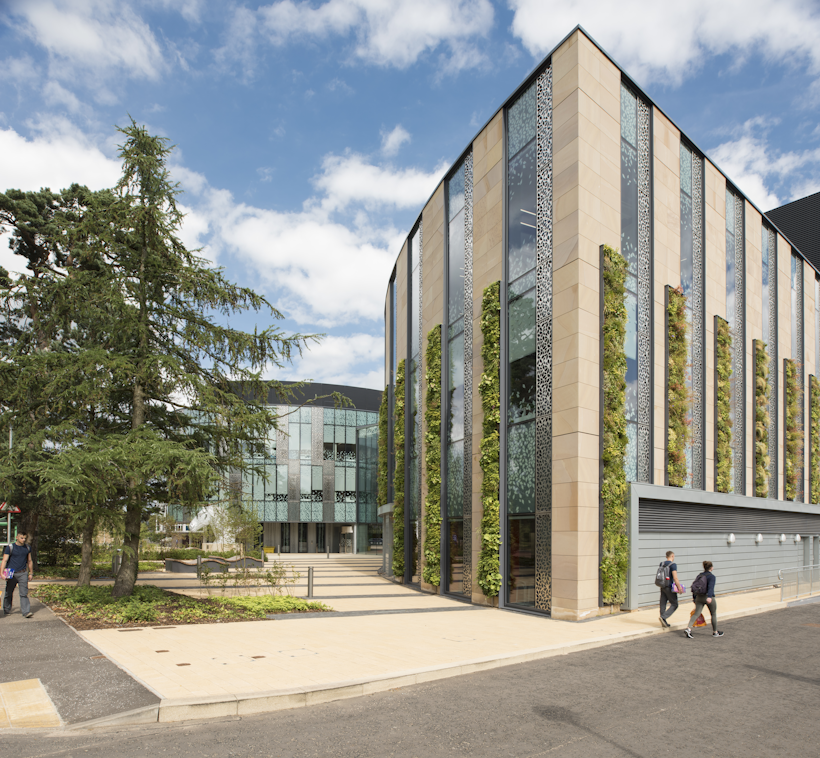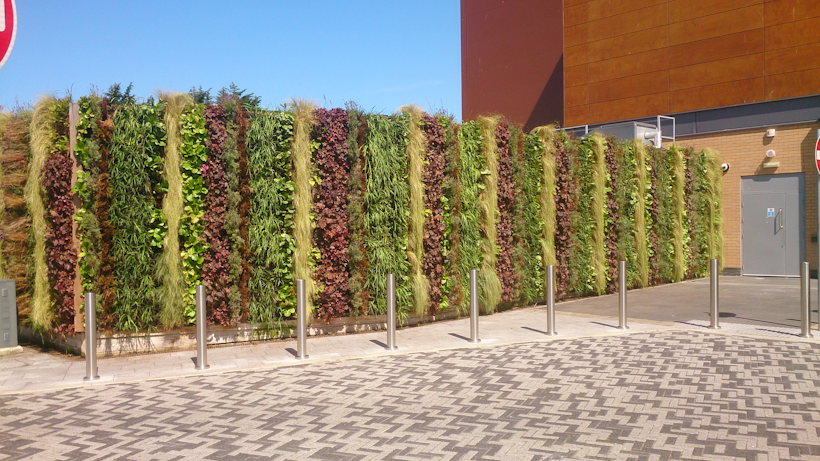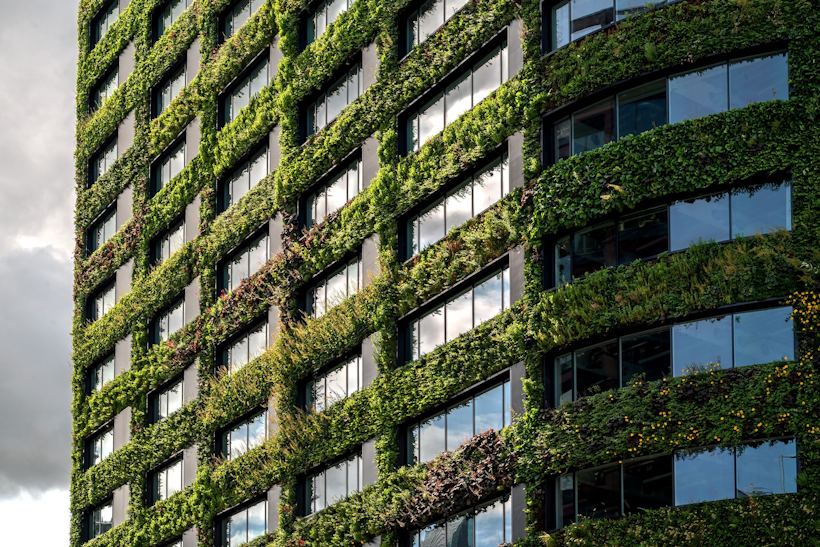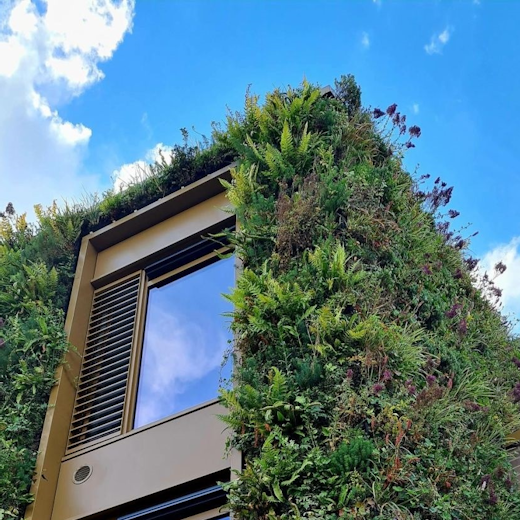Interested to learn more about living walls? From enhancing air quality to fostering biodiversity, here are the top 10 things you know.

1. Contribution to Urban Greening Factor (UGF)
Living walls significantly contribute to the Urban Greening Factor, a tool used by city planners to ensure green space is incorporated into urban development. By increasing the surface area covered by vegetation, they help meet UGF targets without requiring additional ground space.
2. Achieving Biodiversity Net Gain requirements
These vertical gardens support biodiversity by providing habitats for various plant species, insects, and birds. This is particularly important in cities where natural habitats are scarce. Living walls can help reintroduce native plant species and promote ecological balance.
3. Improving air quality
Plants in living walls filter pollutants from the air, including carbon dioxide, nitrogen dioxide, and particulate matter. This natural purification process improves air quality, making urban environments healthier for residents:
- Pollutant filtration: Plants in living walls effectively filter various air pollutants, including:
- Carbon dioxide (CO2): Through photosynthesis, plants absorb CO2, helping to reduce greenhouse gas levels.
- Nitrogen dioxide (NO2): A common pollutant from vehicle emissions, NO2 is absorbed by plant leaves.
- Particulate matter (PM): Tiny particles suspended in the air can be trapped by plant leaves and stems.
- Oxygen production: As plants photosynthesise, they release oxygen, increasing oxygen levels in urban areas.
- Phytoremediation: Some plants can break down or stabilise certain pollutants, further purifying the air.
- Quantifiable benefits: Studies have shown that strategically placed living walls can reduce street-level air pollution by up to 30% for nitrogen dioxide and 20% for particulate matter.
4. Reducing urban heat island effect
Living walls help mitigate the urban heat island effect where cities experience higher temperatures than their rural surroundings due to human activities and extensive concrete surfaces. The plants cool the air through evaporation and provide shade, reducing the need for air conditioning.
5. Promoting wildlife
Vertical gardens create microhabitats that attract wildlife, such as birds and pollinators. These green spaces become stepping stones for urban wildlife, promoting greater biodiversity and ecological connectivity in cities.


8. Living walls are natural insulators
Living walls provide additional insulation to buildings, helping to regulate indoor temperatures. This natural insulation reduces energy consumption for heating and cooling, leading to lower utility bills and reduced carbon emissions:
- Studies have shown that living walls can reduce cooling loads by approximately 30%, which translates to energy savings of 3.6 to 4.8 kWh per day according to Sage Journals.
- According to the London Living Roofs and Walls Report 2019 buildings with living walls could save up to 59% of energy required for heating and cooling.
9. Living walls help with stormwater retention
Living walls absorb rainwater, reducing runoff and decreasing the burden on urban drainage systems. This natural water management helps prevent flooding and maintains groundwater levels.
10. Top Fire Ratings with Viritopia living walls
Our living wall systems are designed with fire safety in mind, using fire-resistant materials and plants. These systems comply with stringent fire safety regulations, ensuring they do not compromise building safety.

Viritopia the world’s leading Living Wall specialist
With nearly 6,000 living wall and green roof projects completed and 36 million plants integrated, Viritopia is a leader in the field of urban greening.
Our expertise ensures that each project not only enhances aesthetic appeal but also delivers on environmental and social benefits. If you are considering a commercial living wall project, arrange a consultation today. We’ll help you transform your urban space into a green oasis.
Living wall case study: Eden at New Baliey
Known as Europe's largest living wall, Eden at New Bailey in Salford, Manchester shows how Viritopia’s living walls can transform urban places.
The 3,900m² green façade, wrapped on all elevations across the building, features a 20,000-liter self-sufficient rainwater harvesting tank and took around 10 months to install.
This extensive living wall helps control the urban heat island effect and significantly increases biodiversity. With over 16 tonnes of soil and 33 different plant species, totalling 350,000 plants, Eden has achieved a Biodiversity Net Gain (BNG) of 174%.
This project shows the effectiveness of living walls in enhancing urban environments and promoting sustainability.
Living Walls from Viritopia
With over 20 years of experience of designing and maintaining biophilic infrastructure, Viritopia can create a detailed plan of how a scheme will meet regulatory requirements.

.jpg?w=4000&q=90&auto=format&fit=crop&crop=edges,focalpoint&fm=png)

6. Improving mental well being
Green spaces are known to have a positive impact on mental health. The presence of green walls in urban areas can reduce stress, improve mood, and enhance overall well-being.
7. Reducing urban noise
The dense foliage of living walls acts as a sound barrier, absorbing and deflecting urban noise. This creates quieter, more pleasant environments, particularly beneficial in bustling city centres: